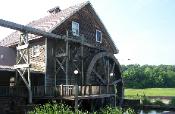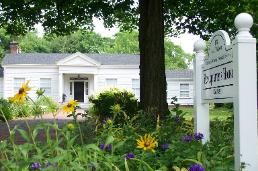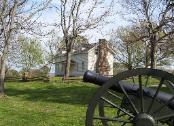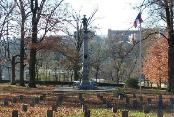

Fayetteville Confederate
Cemetery and Monument
The historic burial ground
overlooking Fayetteville holds
the graves of Southern men
killed in the surrounding area.
Cemetery and Monument
The historic burial ground
overlooking Fayetteville holds
the graves of Southern men
killed in the surrounding area.
Fayetteville, Arkansas - Historic Sites & Points of Interest
ExploreSouthernHistory.com - Historic Sites of Fayetteville, Arkansas
ExploreSouthernHistory.com - Historic Sites of Fayetteville, Arkansas

| Headquarters House in Fayetteville The historic Headquarters House is a significant historic site and played an important role in the Battle of Fayetteville, Arkansas. |
History in Northwest Arkansas
The beautiful city of Fayetteville holds a
special place in the history of Arkansas. Rich
in historic sites and surrounded by natural
beauty, Fayetteville was an important city long
before the Walton family turned Northwest
Arkansas into one of the fastest growing
areas of the country.
Home to the University of Arkansas, the city of
Fayetteville was founded in 1828 on lands
previously claimed by the Western Cherokee,
who began a relocation into what is now
Oklahoma at about that same time. Settlers,
including several prominent Cherokee, had
already made homes in the area by the time.
In a unique moment of history, Sarah Ridge
came to live in Fayetteville in 1839 after her
husband, the Cherokee leader John Ridge,
was assassinated by an opposing party. Her
home still stands at 230 West Center.
Incorporated in 1836, the same year that
thousands of unfortunate beings forced west
on the Trail of Tears began passing through,
Fayetteville grew into a prosperous small city
by the time of the Civil War. From 1861-1865,
however, the town was the scene of much
violence and hardship.
Advancing across the Ozarks during the
wintry early months of 1862, the Union army
of General Samuel R. Curtis marched across
the line into Northwest Arkansas and took up
positions at Pea Ridge. A subsidiary force
led by General Alexander Asboth, a former
Hungarian freedom fighter, drove resisting
Confederates through Fayetteville and briefly
occupied the city.
Asboth and his forces soon withdrew back to
their main body, however, as Major General
Earl Van Dorn led his Confederate Army out
of the Boston Mountains and onto the Ozark
Plateau of Washington and Benton Counties.
The Battle of Pea Ridge (also called Elkhorn
Tavern) was fought just north of Fayetteville
on March 7-8, 1862. The site where more
than 3,000 men lost their lives is now a
national park area. Pea Ridge was a bloody
disaster for the Confederate forces and the
Union army claimed possession of
Northwest Arkansas.
More fighting took place on November 28,
1862, at nearby Canehill (then spelled Cane
Hill), when 5,000 Union soldiers attacked
three brigades of Confederate cavalry. The
fighting lasted all day and was a preliminary
episode to a second major battle that would
be fought nine days later.
On December 7, 1862, Confederate General
Thomas Hindman led 11,000 men and 22
cannon out of the Boston Mountains in hopes
of destroying the divided Union Army of the
Frontier. The result was the Battle of Prairie
Grove, fought just 12 miles from downtown
Fayetteville. The bloody stalemate left
thousands of men dead or wounded, but
once again the Federals prevailed when
Hindman realized he could not defeat them
and withdrew during the night.
Fayetteville itself was attacked by Southern
forces during the Battle of Fayetteville on April
18, 1863. Once again Confederate troops
were unsuccessful in their attack and
withdrew back into the sheltering mountains.
special place in the history of Arkansas. Rich
in historic sites and surrounded by natural
beauty, Fayetteville was an important city long
before the Walton family turned Northwest
Arkansas into one of the fastest growing
areas of the country.
Home to the University of Arkansas, the city of
Fayetteville was founded in 1828 on lands
previously claimed by the Western Cherokee,
who began a relocation into what is now
Oklahoma at about that same time. Settlers,
including several prominent Cherokee, had
already made homes in the area by the time.
In a unique moment of history, Sarah Ridge
came to live in Fayetteville in 1839 after her
husband, the Cherokee leader John Ridge,
was assassinated by an opposing party. Her
home still stands at 230 West Center.
Incorporated in 1836, the same year that
thousands of unfortunate beings forced west
on the Trail of Tears began passing through,
Fayetteville grew into a prosperous small city
by the time of the Civil War. From 1861-1865,
however, the town was the scene of much
violence and hardship.
Advancing across the Ozarks during the
wintry early months of 1862, the Union army
of General Samuel R. Curtis marched across
the line into Northwest Arkansas and took up
positions at Pea Ridge. A subsidiary force
led by General Alexander Asboth, a former
Hungarian freedom fighter, drove resisting
Confederates through Fayetteville and briefly
occupied the city.
Asboth and his forces soon withdrew back to
their main body, however, as Major General
Earl Van Dorn led his Confederate Army out
of the Boston Mountains and onto the Ozark
Plateau of Washington and Benton Counties.
The Battle of Pea Ridge (also called Elkhorn
Tavern) was fought just north of Fayetteville
on March 7-8, 1862. The site where more
than 3,000 men lost their lives is now a
national park area. Pea Ridge was a bloody
disaster for the Confederate forces and the
Union army claimed possession of
Northwest Arkansas.
More fighting took place on November 28,
1862, at nearby Canehill (then spelled Cane
Hill), when 5,000 Union soldiers attacked
three brigades of Confederate cavalry. The
fighting lasted all day and was a preliminary
episode to a second major battle that would
be fought nine days later.
On December 7, 1862, Confederate General
Thomas Hindman led 11,000 men and 22
cannon out of the Boston Mountains in hopes
of destroying the divided Union Army of the
Frontier. The result was the Battle of Prairie
Grove, fought just 12 miles from downtown
Fayetteville. The bloody stalemate left
thousands of men dead or wounded, but
once again the Federals prevailed when
Hindman realized he could not defeat them
and withdrew during the night.
Fayetteville itself was attacked by Southern
forces during the Battle of Fayetteville on April
18, 1863. Once again Confederate troops
were unsuccessful in their attack and
withdrew back into the sheltering mountains.
Many of the Southern dead from these battles
are buried at Fayetteville's Confederate
Cemetery, near the intersection of Rock and
Willow just east of the downtown area. The
graves of Union dead can be found at
Fayetteville National Cemetery at 700
Government Avenue. The Headquarters
House, which played a key role in the Battle
of Fayetteville, is now owned by the
Washington County Historical Society.
The years after the Civil War witnessed the
founding of the University of Arkansas in
Fayetteville. Through the years, the university
has played a major role in the development
not just of the city, but of the state and nation.
Historic Old Main, the oldest building on
campus, was completed in 1875.
Famed for its Razorbacks athletics teams,
the University of Arkansas lists among its
former students and faculty members
President Bill Clinton and Secretary of State
Hillary Clinton; architect E. Fay Jones;
sportcaster Pat Summerall; coaches Barry
Switzer, Jimmy Johnson and Lou Holz;
developer of the pacemaker, Walter Keller,
and Dallas Cowboys owner Jerry Jones.
A modern and prosperous city, Fayetteville
has repeatedly been named one of the ten
best places in America to live and work. It is
an outstanding and charming Southern
community.
are buried at Fayetteville's Confederate
Cemetery, near the intersection of Rock and
Willow just east of the downtown area. The
graves of Union dead can be found at
Fayetteville National Cemetery at 700
Government Avenue. The Headquarters
House, which played a key role in the Battle
of Fayetteville, is now owned by the
Washington County Historical Society.
The years after the Civil War witnessed the
founding of the University of Arkansas in
Fayetteville. Through the years, the university
has played a major role in the development
not just of the city, but of the state and nation.
Historic Old Main, the oldest building on
campus, was completed in 1875.
Famed for its Razorbacks athletics teams,
the University of Arkansas lists among its
former students and faculty members
President Bill Clinton and Secretary of State
Hillary Clinton; architect E. Fay Jones;
sportcaster Pat Summerall; coaches Barry
Switzer, Jimmy Johnson and Lou Holz;
developer of the pacemaker, Walter Keller,
and Dallas Cowboys owner Jerry Jones.
A modern and prosperous city, Fayetteville
has repeatedly been named one of the ten
best places in America to live and work. It is
an outstanding and charming Southern
community.

Battle of Prairie Grove
The sounds of cannon and
musket fire from Prairie Grove
was distinctly heard 12 miles
away in Fayetteville.
The sounds of cannon and
musket fire from Prairie Grove
was distinctly heard 12 miles
away in Fayetteville.

Johnson Mill
Now a beautiful inn, the old
Johnson Mill is one of the
many historic structures in the
Fayetteville area.
Now a beautiful inn, the old
Johnson Mill is one of the
many historic structures in the
Fayetteville area.

Battle of Cane Hill
Battle of Fayetteville
Battle of Pea Ridge
Battle of Prairie Grove
Boston Mountains Scenic Loop
Confederate Cemetery
Devil's Den State Park
Eureka Springs
Fayetteville National Cemetery
Ozarks of Arkansas
Historic Sites in Arkansas
Explore other Southern Historic Sites
Battle of Fayetteville
Battle of Pea Ridge
Battle of Prairie Grove
Boston Mountains Scenic Loop
Confederate Cemetery
Devil's Den State Park
Eureka Springs
Fayetteville National Cemetery
Ozarks of Arkansas
Historic Sites in Arkansas
Explore other Southern Historic Sites


Devil's Den State Park
Taking its name from its
myriad of caves, bluffs, rock
formations and ravines, the
park is popular with all ages.
Taking its name from its
myriad of caves, bluffs, rock
formations and ravines, the
park is popular with all ages.

Ozarks of Arkansas
Fayetteville is situated in the
beautiful Ozarks region,
known for its mountains,
scenery, culture and historic
sites.
Fayetteville is situated in the
beautiful Ozarks region,
known for its mountains,
scenery, culture and historic
sites.
| Copyright 2011 by Dale Cox All rights reserved. |

Custom Search




